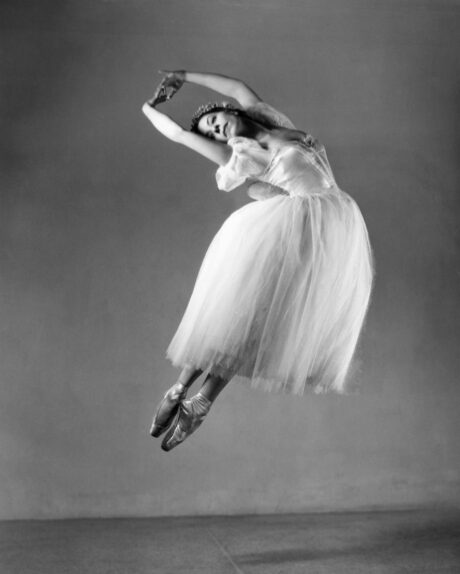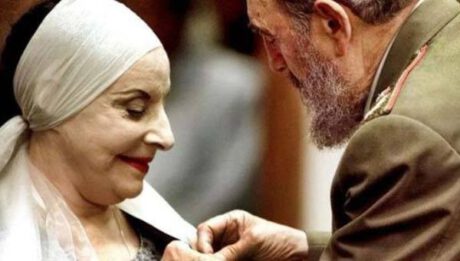Divadelní noviny > Zahraničí Zprávy
Zemřela Alicia Alonso

Foto archiv
21. 12. 1920 Havana, Kuba – 17. 10. 2019 Havana, Kuba
Legendární kubánská primabalerína, choreografka, dlouholetá umělecká ředitelka Ballet Nacional de Cuba.
Narodila se jako Alicia Ernestina de la Caridad Martínez Hoyado do rodiny bývalého vojáka a švadleny. Se studiem tance začala ve Španělsku, kde brala hodiny flamenka. Po návratu do vlasti jako jedenáctiletá nastoupila do hodin baletu u Nikolaje Javorského a velmi brzy se dostala na jeviště – debutovala 29. prosince 1931, v říjnu následujícího roku se objevila v baletu Spící krasavice. V šestnácti letech se vdala za svého spolužáka, tanečníka Fernanda Alonsa (1914 – 2013) a odešli spolu do New Yorku, kde Alicia pokračovala ve studiu ve Škole amerického baletu (School of American Ballet). V roce 1938 se jim narodila dcera Laura, kterou však záhy poslali do Aliciiny rodiny na Kubu, aby se mohli věnovat extrémně intenzivním tréninkům. Na newyorském jevišti se poprvé představila v muzikálech Great Lady a Stars in Your Eyes, poté v baletu Caravan George Balanchina a v roce 1940 nastoupila do nově založeného souboru Ballet Theatre (dnes American Ballet Theatre) Lucii Chase a Richarda Pleasanta. Byla považována za jednu z největších interpretek své generace, kritika oceňovala jak její herectví, tak silnou techniku, která v některých aspektech dosahovala atletických výkonů jejích mužských kolegů.

Giselle, 1947. Foto Granger Historica
V roce 1941 jí lékaři diagnostikovali odchlípenou sítnici. Podrobila se třem operacím, během kterých strávila více než rok na lůžku se zavázanýma očima. Operace ale nepomohly a Alicia se musela vyrovnat se ztrátou periferního vidění. Kvůli tomuto omezení vyžadovala absolutní přesnost od tanečních partnerů, orientovala se podle silných světel a kolem jeviště byl natažen tenký drát. Přes tyto problémy zůstala primabalerínou Ballet Theatre a účinkovala zde do roku 1948. Za tu dobu vytvořila mnoho rolí – mezi jinými především Giselle (1943, partnerem jí byl slavný Anton Dolin), která se stala jednou z těch, které se s ní pojily celý život. Tančila rovněž v premiérách baletů Anthonyho Tudora (Undertow 1943), Agnes de Mille (Fall River Legend 1948) nebo G. Balanchina, který přímo pro ni vytvořil jeden ze svých nejslavnějších symfonických baletů Téma a variace (1947) na závěrečnou větu Čajkovského Suity č. 3 G dur pro orchestr.
Po odchodu v roce 1948 z New Yorku se vrátila na rodnou Kubu. Zde založila spolu se svým manželem a jeho bratrem, choreografem Albertem (v jehož baletu Carmen Suite na hudbu Rodiona Ščedrina dosáhla podobného úspěchu jako další velká tanečnice 20. století Maja Plisecká) soubor Alicia Alonso Ballet Company. Ten byl o osm let později přejmenován na Ballet de Cuba, kvůli finančním problémům však následující rok zkrachoval. Když se však roku 1959 dostal na Kubě k moci Fidel Castro a jeho komunistický režim, finanční situace se naklonila příznivěji (Castro slíbil podporu národním kulturním programům) a Alonso založila soubor fungující dodnes – Ballet Nacional de Cuba a později i novou taneční školu.
Vedle těchto aktivit hostovala do vysokého věku jako tanečnice po celém světě. Tančila například se souborem Ballet Russe de Monte Carlo (1955–1959), v pařížské Opeře, s Dánským národním baletem a dalšími soubory napříč Evropou, Jižní a Severní Amerikou i Asií. Jako první západní umělkyně hostovala ve Velkém divadle v Moskvě (1957) a Mariinském divadle v Petrohradě (tehdejším Leningradě, 1958).

K jejím sedmdesátinám jí v roce 1990 blahopřál i Fidel Castro. Foto archiv
Propojení s novým režimem otevřelo dveře tvorbě kubánského baletního umění, samotné Alonso však na několik let znemožnilo tančit ve Spojených státech – jednak se od ní odvrátilo místní publikum a jednak komunistický režim v 60. – 80. letech výjezdy svých umělců až na výjimky zakazoval. Se svým souborem nicméně v letech 1967 a 1971 hostovala v Kanadě, po ukončení válečného konfliktu ve Vietnamu (30. dubna 1975) jí bylo povoleno i dvojí hostování ve Státech (v letech 1975 a 1976).
Do vysokého věku byla uměleckou ředitelkou Ballet Nacional de Cuba, ačkoli již byla téměř slepá. Jako choreografka se věnovala především inscenování tradičních klasických baletů. Vytvořila mj. svou verzi Giselle, romantického Pas de Quatre Julese Perrota, či Spící krasavice, Labutího jezera a Marné opatrnosti, která se uváděla i v pražské Státní opeře (1980–1990).

V roce 2014, když jí bylo 96 let, zcela oslepla. Jak ale říkala, nepřestala ani tak tančit. Tančila ve svých představách. Foto archiv
Za svou kariéru byla ověnčena mnoha cenami a řády, například titulem prima ballerina assoluta, kubánským státním Řádem Josého Marti, francouzským Řádem umění a literatury nebo cenou Benois de la Danse za celoživotní dílo (2000, udělen v tom roce zcela poprvé). V roce 1975 se rozvedla.
///

Alicia Alonso. Foto archiv
Britský deník The Daily Telegraph uveřejnil 30. července 2013 nekrolog manžela Alicie Alonso Fernanda (zde), ve kterém analyzuje uměleckou dráhu obou umělců. Dovolujeme si jej čtenářům i-DN bez překladu nabídnout:
Fernando Alonso, who has died aged 98, was the architect of Cuba’s emergence as a world power in classical ballet and played a crucial part in saving the career of his superstar ballerina wife, Alicia Alonso, after she became blind when young.

V roce 1939. Foto archiv
The 20-year-old ballerina was emerging as a major new talent in New York when she suffered detached retinas and effectively lost her sight. Ordered by doctors to lie motionless for a year after a series of operations, she feared her career was over before it had even begun. But as she recovered, Fernando sat beside her, helping her to retain her body’s memory of her leading roles through tiny movements of her feet and fingers. Within two years she had returned to the stage and, despite permanent visual impairment, built one of the great careers in dance.
It was an experience that transformed not only her life, but also Cuban ballet. For after observing how his wife had learned to balance without seeing, and continued to deploy brilliant speeds in spins and travelling jumps, Fernando Alonso developed an analytical understanding of dance mechanics that generated an explosion of talent in his homeland. As a result of his unique methodology, Cuban ballet dancers are trained to match a remarkable sense of balance with a bravura style.

Alicia a Fernando Alonsovi v choreografii Undertow v American Ballet Theater, New York (40. léta). Foto archiv
While the Caribbean island might seem an unlikely base for the aristocratic old-world art of classical ballet, Fernando Alonso identified real affinities: “Cubans inherited from the Spaniards a virile sense of dance, with a hint of toreador-like aggression. From the Africans, we inherited a readiness to demonstrate those feelings with repetitive rhythms, plus a pronounced masculine sexuality in the men and natural charm in the women… It’s the male and female elements which create a Cuban way of dancing.”
Fernando Alonso was born in Havana on December 27 1914, the elder of two sons of Laura and Matias Alonso, who were of Spanish extraction. Mrs Alonso ran a musical and dance society, and the brothers took dance lessons with a resident Russian ballet teacher. Their fellow student was a girl who lived nearby, Alicia Martinez Hoyo, with whom Fernando fell in love.

Foto archiv
As she was 15 and he 21, his parents tried to break up the relationship by sending him to Florida to study; but Alicia followed him, and their daughter Laura was born soon after. Fernando’s brother, Alberto, then joined them as Alicia’s ballet partner, and they made for New York. Fernando joined the Ballet Mordkin, Alberto the Ballet Russe de Monte Carlo; while young Alicia, toting her baby, Laura, found work in Broadway musicals – the infant became a favourite of Ethel Merman.
The teenage Alicia was a striking but still unfinished ballet dancer, and her husband coached her constantly, applying everything he observed from the international dancers alongside whom he and his brother were performing. In 1941, aged 20, she was hired by the major classical company, Ballet Theater, only to find her nascent career threatened by the detached retinas.
Within two years, however, Fernando had coached her back to full fitness and she was called upon by the company to replace its sick superstar, Alicia Markova, in her greatest role, Giselle. The company arranged for very strong lights, invisible to the audience, to guide the Cuban ballerina. Her male partners were also taught by Fernando to murmur directional instructions to her as they danced.

Foto archiv
In 1948, due to disruptions within Ballet Theater, Fernando, Alicia and Alberto returned to Cuba to establish the Ballet Alicia Alonso, formed to support the ballerina’s world tours. The brothers set about training native dancers for the company, and Fernando developed a dance syllabus based on his observations of all the major world ballet schools as well as the insights he had learned from working with his almost-blind wife.
One ballerina recalled how her class was taught to balance on pointe with their eyes closed, so as to master an inner sense of equilibrium. Another of his ideas was to set children spinning on rockers torn off old rocking chairs so that they learned to understand the forces involved in fast turning. To this day Cubans are particularly noted for their combination of old-world Russian stylishness and vigorous technical virtuosity.

S Reyesem Fernándesem jako Giselle (1960). Foto Annemarie Heinrich
During the 1950s the Alonso brothers joined the Communist Party in opposition to General Batista, and after Castro’s 1959 coup they persuaded him to fund a Cuban National Ballet and a national schooling system under their direction.
Under Fernando Alonso’s remarkable curriculum, Havana became internationally renowned for its ballet training, despite material deprivations. In the early 1960s Cuba’s young ballerinas were regularly winning gold medals in Soviet competitions, and the Bolshoi Ballet, impressed, started exchanges of dancers and teachers.
However, as Alicia became more autocratic as head of the Cuban National Ballet, relations with her husband and daughter broke down. In 1975, after they divorced, Fernando set up a ballet school and company in Camagüey, which is now Cuba’s second ballet company, though not permitted by the government to tour abroad.

Foto archiv
Cuba’s 11 million-strong population continues to support some half dozen professional companies, and Cuban ballet teachers now hold major positions worldwide. Fernando Alonso taught into his nineties, and was awarded Cuba’s National Dance Prize for Lifetime Achievement in 2000. He also won the international Benois de la Danse Lifetime Achievement award in 2008.
Fernando Alonso is survived by his former wife, who at 92 still runs the Cuban National Ballet, and by their daughter, also a ballet teacher. Alberto Alonso died in 2007, aged 93. Fernando Alonso, born December 27 1914, died July 27 2013.
/Pro i-DN z více zdrojů připravil hul/
Komentáře k článku: Zemřela Alicia Alonso
Přidat komentář
(Nezapomeňte vyplnit položky označené hvězdičkou.)





